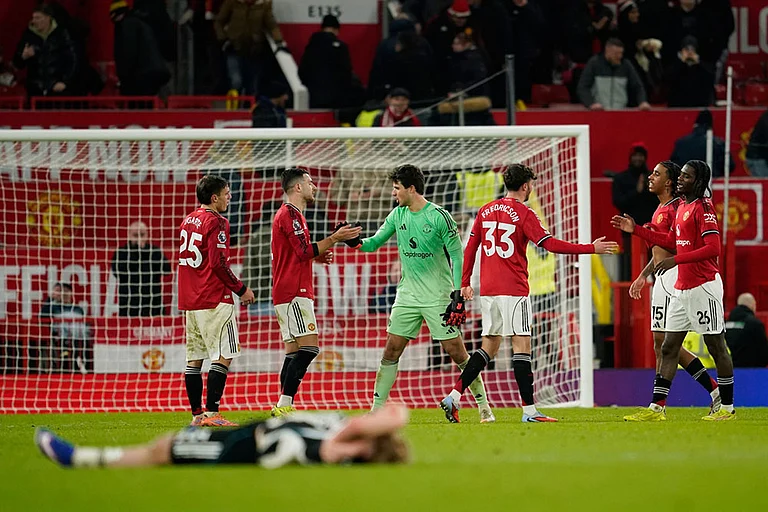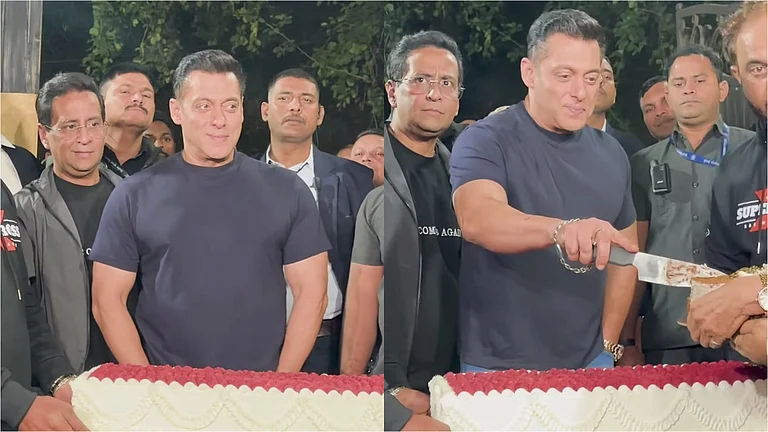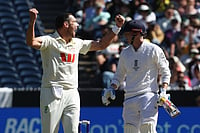Elementary education secretary Kusum Bansal has this lovely story to tell. A school in the North-east sent her a plaintive request saying that there are no benches for the students to sit on. Bansal wrote back saying that the tenth plan allocation for the sector was half of what she’d asked for. "What would you rather have? A teacher or a lot of benches?"
It’s a dilemma Indian budgets have traditionally grappled with, though with little success. Lots of money to some or some money to all? Raise taxes or cut spending? Growth or equity? The challenge before the budget that will be presented on July 8 by liberalisation’s golden men, Manmohan Singh and P. Chidambaram, is to find that elusive golden mean as if, quite literally, their survival depended on it.
At its easiest, it’s a hell of a job. Especially if one were to consider fulfiling even a fifth of the Common Minimum Programme’s laudable aims, which have impressed development guru Jeffrey D. Sachs (see interview). But that is what Prime Minister Manmohan Singh has instructed his team: follow the CMP to its last e. To his finance colleague, there is a special instruction: don’t forget the average Indian (aam aadmi). There’s also an advisory council headed by Sonia Gandhi to monitor the progress made in fulfiling the CMP. Council member and Congress economic cell secretary Jairam Ramesh says candidly: "The CMP is our Bible. It is everything."

Jairam Ramesh also insists that barring two points (Electricity Act review and misuse in double taxation), the CMP echoes the Congress economic vision. Still, to keep the CMP firmly in the background of the budget is only half the story. The reformists argue that for all its lofty ideas, the CMP is just a high-sounding five-year plan and "radical reforms" can go on under its benign shadow. At the other end are those who feel that with the amount of stale, tried-and-failed ideas being revived in the CMP, we can simply bid goodbye to reforms. Indeed, bureaucrats say the finance ministry is the last place to look for reforms now.
But, says IGIDR (Indira Gandhi Institute of Development Reserarch) professor Ashima Goyal: "Higher growth and lower interest rates over the past year have improved the budgetary picture and given this government some freedom. With good policies, it won’t hurt the investment mood and manufacturing recovery." Industrialist Rahul Bajaj agrees about the investment mood. "I’m worried about a lot of things in the CMP, especially job reservations. There’s much idle talk and we’re waiting for the budget to clear the air," he says. Wise words, for the budget will prove both extremist groups wrong. As is clear from the PM’s maiden speech where he promised a "new deal" for rural India, a single market for manufactured and agri-products, an energy policy package, and urban renewal through active public-private partnership in building infrastructure.

Agriclture The PM has promised a'new deal' for rural India.
Contrary to fears, it will be a rewarding but not a giveaway budget. It will expand the nineties’ narrow-focused macroeconomic reforms and take them forward, while concentrating on extending the responsibilities from the Centre to the states and the benefits from the cities to the villages, from the rich to the poor.
The budget will focus on increased government spending, but it will also juggle the basket efficiently. It will direct money to long-neglected areas—farmers, education, health, rural infrastructure—and make sure that the spenders, mainly the states, have enough leeway and compulsion to use it wisely. Says a top finance ministry official: "It will be a tough but forward-looking budget, supportive of production and investment.It will be more micro-oriented, yes, but the macro element—of fiscal policy and investment promotion—cannot be ignored.In fact, the fiscal rectitude will surprise many."
This fiscal discipline would also be true to the CMP. The programme gives out a clear deadline—note, there is only one deadline in the document—for the revenue deficit to end by 2009. "A detailed roadmap for accomplishing this will be unveiled in Parliament in 90 days," it says. So it will surprise those worried about the leftist grip on the Manmohan Singh government. Says CPI(M) politburo member Prakash Karat: "Not all our proposals have been adopted. We had asked for universal pds, state debt writeoff, etc. All that has been diluted. Nor are we closely involved in budget-making. I want to dispel the general impression that we’re pulling the strings of economic policy. We aren’t breathing down the FM’s neck."
On the contrary, both Karat and colleague Sitaram Yechury have often made their dissatisfaction public in party mouthpiece People’s Democracy. That’s part of a deliberate strategy of constructive criticism the party has decided to adopt with the government. Like brakes on the engine of the government, it has a clear role. "We don’t have much expectation from this budget," says Karat, "considering the limited time and the lack of manoeuverability in the numbers. We’ve had our say in the CMP. The FM has assured us the funds are there and we believe him. We’ll take up the issues, if any, after the budget."

Education Funds outlay will be be raised to 6% of the GDP
The FM may not have made hasty promises. For instance, the hike in plan outlays in education and health to 6 per cent and 3 per cent wouldn’t land the budget in great trouble. Since both are state subjects, the Centre could end up spending only about Rs 5,000 crore a year extra, according to NCAER economists D.K. Pant, R. Chadha and T.C.A. Srinivasa-Raghavan, something that a 2 per cent cess on all central tax revenues, as proposed in the CMP, will yield comfortably. However, if the cess is applied only to direct taxes—and that is only fair—it will yield only Rs 2,500 crore.
The other area of concern is the National Employment Guarantee Act, the credit for which must go to the CPI(M). Finance ministry officials dismiss this as a purely political decision and urge one to look at it as a national food-for-work scheme. NCAER estimates that this would lead to an extra (apart from the existing job schemes) annual expenditure burden of Rs 7,000 crore on the Centre, going by the current rates of funds-sharing and of the reduction in the number of poor. (Some 100 million people have gone above the poverty line in the nineties.) Nothing that the back cannot bear.

Health The outlay here will be raised to 3% of the GDP, to about Rs 4 lakh cr
Provided, of course, that the revenue situation gives. NCAER experts have a solution for this too. They say that service tax alone can raise the extra Rs 12,000 crore because just one sector, transport, has the potential to raise Rs 15,000 crore. The other avenue is to implement the Kelkar tax report fully, both on direct and indirect taxes. This is integrated in the CMP, say ministry sources, and therefore could be a fait accompli. Though the proposals are revenue-neutral, the radical reforms will improve tax-GDP ratio from 15 per cent now to 18 per cent. Three per cent of GDP is Rs 4 lakh crore! Enough to fulfil half the CMP!
On the other hand, some say that immediate changes in tax rates are unlikely, except for reliefs for entry-level taxpayers. Chidambaram has fuelled expectations of a black money-mopup scheme but that may not come to pass as Manmohan Singh is against such instant fixes.As for the revenue situation of the states, state VAT introduction, whose deadline is now April 1, 2005, will go a long way in fixing that.Sixteen states are ready for a switchover, and the intransigent northern states are expected to learn from the experience of Haryana, which went it alone last fiscal and increased its revenues 32 per cent.A measure to lighten the debt burden of the states is also expected in the budget, apart from steps for a relook at the funds-flow formula.

Disinvestment It netted Rs 16,000 cr last fiscal. This time, Rs 200 cr at best
Still, because of its pro-poor leanings, the government is ignoring some vital elements, notably privatisation and epf rate cut. The Congress is emphatic that "case-by-case privatisation" will still happen in 179 PSUs (leaving out the Ashtaratnas and 50 losing ones which will be privatised)—if it’s possible to make out a case—as opposed to CPI(M)’s "case-by-case disinvestment". Till the nitpicking is over, there is an uncovered hole of Rs 16,000 crore in disinvestment. The other is the reluctance to slash the epf rate, which at 9.5 per cent on a corpus of Rs 1,40,000 crore, is enriching its 83 million susbscribers compared to the small savings rate of 8 per cent and 6 per cent government paper.
Yet, the farm credit programme announced by Chidambaram will, according to bankers, result in a 30 per cent rise in the flow to the sector, or Rs 10,500 crore in 2004-05. Add to it the expected investments which will materialise because banks are anyway flush with funds. And the already-firming up global interest rate climate, and we are looking at a rising interest rate and inflation (at 5.5 per cent now) scenario at home. Who will it hurt the most? The government. A downward pressure on interest rates is impossible as it will hurt the trade account where the deficit is up at $3.8 billion.
Which is why, say North Block men, all this hullabaloo of a giveaway budget is just idle talk. "A six per cent deficit is impractical because even if you have the money, many ministries, including defence, are unable to spend it. Even the NHAI took four years to firm up all its projects." The quantum of money to be spent hinges on the absorptive capacity of the sector, which if absent will result in a lot of saved expenditure in March 2005.
There’s also the Fiscal Responsibility and Budget Management Act coming in two months, fully endorsed by the CMP and laying down the golden rule: government won’t borrow to consume, only to invest. For this, delivery has to improve sharply. Even in a rich state like Karnataka, 37 per cent of gram panchayats spent less than Rs 20 per person a year on basic services. Across India, a quarter of teachers are absent from school on any given day. Instead of in taxation, innovations have to come there (See ToSpread The Jam ).
Says Subir Gokarn, CRISIL chief economist: "Indian reforms are a very haphazard process—no clear goal, no strategy, no thinking through. And the finance ministry is not anymore at the vanguard of reforms; it can only act as an advisor." More efficient delivery and better services—education, health and infrastructure—are now the biggest challenges for further rapid growth, in itself a virtuous cycle. If Manmohan Singh-P. Chidambaram can get the economy into such a cycle, they may finally break the vicious cycle of anti-incumbency.


























